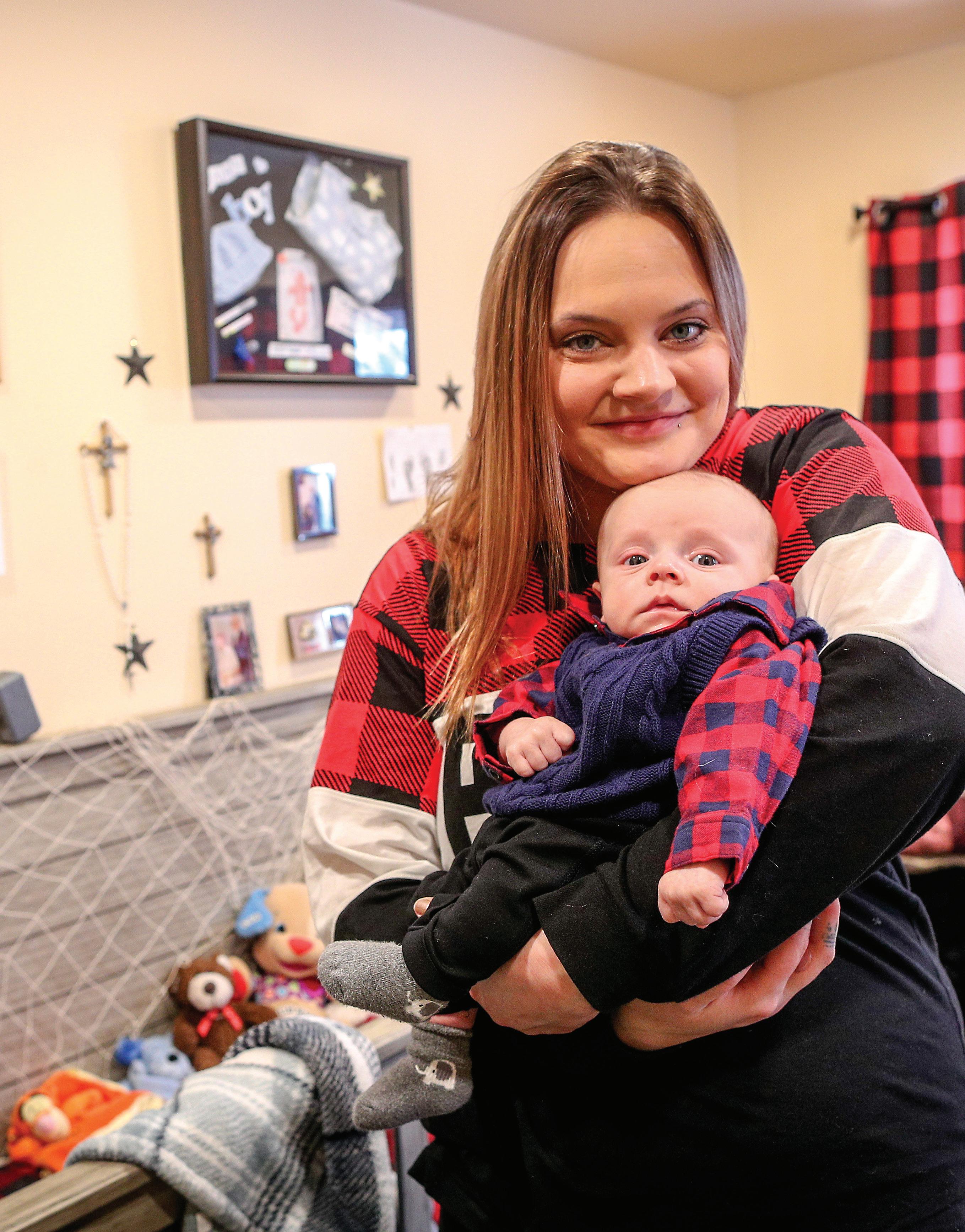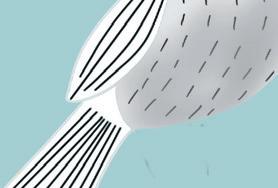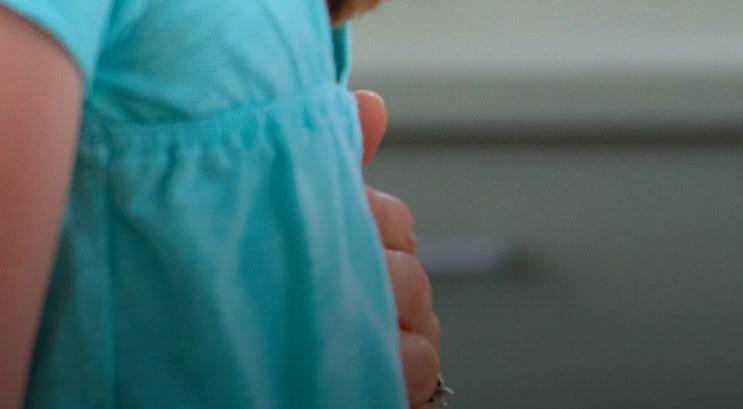

Family travel Kids in the kitchen Pets Hands-on crafts GETTING Crafty Duluth mom searches the sales to decorate baby’s room Children's health • Professionals provide tips about mental health • Toddler survives accident with window blind • Physical therapy exercises treat scoliosis MARCH • APRIL 2019

2 | may • june 2022 Non-Profit Home Care Agency We accept major insurance plans; Medicaid and private pay. Call our Duluth office and ask about the possibilities! 218-724-2800 SERVING PEOPLE STATEWIDE www.accracare.org HELPING FAMILIES FOR OVER 25 YEARS. Accra provides support to families that need help in their homes for a loved one with a disability. We’ll help you navigate the different services available to you. PCA Choice is one of our services that allows you to choose a family member or friend to be your paid caregiver.
march • april 2019
to our readers
We’ve taken a turn toward spring with this issue, but we’re not there yet. From family trips south, tick protection for pets, warm baking with kids and more, we hope you’ll find a good spot to cuddle up and enjoy the stories we’re sharing.

group publisher
Neal Ronquist
executive editor
Rick Lubbers
advertising director
Megan Wedel
advertising sales manager
Kathleen Pennington
features editor
Beverly Godfrey
contributors
Bonnie Ambrosi
Clint Austin
Andrea Busche
Derek Montgomery
Photography
Claire Kiger

Melinda Lavine
Kathleen Murphy

Mary Rasch

Kasha Stoll
Connie Wirta
advertising account executives

Ali Comnick Barbie Into ali@momsanddadstoday.com binto@thewomantoday.com 218.428.2929 218.391.6057
Add your event to our calendar at Duluth.com

MAIL CORRESPONDENCE
TO:
Moms & Dads Today 424 West First Street Duluth, MN 55802 magazines@duluthnews.com

MARCH • APRIL 2019 | 3 Always being there for what’s next with superior financial products and services – that’s what membership means. 800-569-4167 • superiorchoice.com Visit our website for a location nearest you. Membership Eligibility Required. Federally Insured by NCUA. Equal Housing Opportunity. EXPERIEN C IN G S UPERIOR MOM EN TS . THI S I S OU R CU RRE N CY . ©2019 Forum Communications Company All rights reserved. No part of this publication may be reproduced without written permission from the publisher. Moms & Dads Today is published bi-monthly by the Duluth News Tribune.
4 Mental health tips for parents 8 New mom hunts for decorating deals 10 ESSENTIA: Toddler survives window blind mishap 14 Parents appreciate inside play event 16 KIDS IN THE KITCHEN: Peanut butter cookies 20 PETS: Springtime and tick prevention 24 ST. LUKE’S: Therapy regimen treats scoliosis 28 FAMILY TRAVEL: Zoo getaways 30 HANDS ON: Delicate quilling crafts 34 Netflix’s ‘Tidying Up’ is a holistic delight 36 Maurices partners with AdoptAClassroom.org 39 Calendar of Events 40 The science behind love’s racing heart 42 KIDS’ CORNER
ON THE COVER: Ashley Gilbert holds her son Zander Haydon in their nursery at their rural Duluth home.
PHOTO BY CLINT AUTSIN / DULUTH NEWS TRIBUNE
Mental health issues touch people of all ages — even children
LOCAL PROFESSIONALS PROVIDE TIPS FOR PARENTS
BY ANDREA BUSCHE
Mental health conditions affecting young people seem to be more prevalent in the news these days. Sometimes, the condition is triggered by a traumatic event, such as bullying, but mental illness can also be genetic.
No matter the cause, many mental health concerns, ranging from anxiety and depression, attention deficit and hyperactivity disorder, and even suicidal thoughts, do not discriminate due to one’s age. Even young children can be affected. And, as with all health conditions, the early detection and treatment of mental illness is imperative.

4 | MARCH • APRIL 2019 Family Health
Two local professionals, Dr. Judith Christianson, child and adolescent psychiatrist at St. Luke’s Outpatient Mental Health Clinic, and Diane Holliday-Welsh, operations administrator, behavioral health and emergency medicine at Essentia, provide some of the warning signs. They also share steps parents can follow, to help ensure your child receives the proper care and treatment.
Warning signs
In most instances, your child will begin to exhibit a predictable set of behaviors indicating that they are struggling with their mental health. “Some signs or symptoms to watch for are changes in behavior, a change in engagement in activities, a change in friendships, and more isolation,” Holliday-Welsh said.
Parents should also monitor their child’s social media messages. Holliday-Welsh is aware of at least one group, made up of four to five young people, who were involved in a suicide pact; they had discussed their plans on the social media site Instagram.
Dr. Christianson said that participation from

your child’s school can also help identify a problem. “Feedback from teachers about how a child is doing at school can be helpful, as educators have exposure to many children,” she said. “This applies all the way down to preschool, especially because symptoms related to conditions such as ADHD or autism may seem more apparent when a child transitions into those more structured settings.”
“In all children,” Dr. Christianson added, “Any big change in behavior would be worth learning more about. A child or teen becoming more isolative, starting to struggle academically, or becoming more reactive/emotional to usual stressors would warrant a parent pausing to check in and learn more about how that child is doing.”


Commonly seen conditions
When it comes to the gamut of mental health concerns, youths can suffer from many of the same conditions as adults. Holliday-Welsh shared that the most commonly seen youth mental health conditions at Essentia are issues related to anxiety, depression and suicidal thoughts or attempts.

MARCH • APRIL 2019 | 5
FREE Orthodontic Consultation (No Referral Needed) Duluth Superior Two Harbors Virginia Hibbing Piedmont International Falls 218-722-4484 arrowheadorthodontics.com
Live Life Smiling
Holliday-Welsh
Christianson
Dr. Christianson breaks it down further, by age. “There is a bit of a divide in children, between adolescents and preadolescents when it comes to commonly seen conditions,” she said. “In pre-adolescents, the most predominant conditions referred to me are disruptive behavior disorders, attention deficit and hyperactivity disorder (ADHD) and anxiety disorders.”
“In the adolescent populations, the most common conditions are depression, anxiety disorders (such as posttraumatic stress disorder, obsessive compulsive disorder, generalized anxiety disorder and social phobia) and ADHD. I also care for a number of individuals with mild to moderate severity autism spectrum disorders; I would say with equal prevalence in both age groups.” Dr. Christianson added that mental health providers also treat eating disorders in youths, such as anorexia, bulimia and binge eating disorder.
First steps
If a parent or guardian suspects their child is suffering, there are a few things they can do. “The first step is to ask your child or teen how things are going,” Dr. Christianson said. “Parents can share with their child what they have observed; for example, noticing that the child is isolating, and asking the child if they have noticed the same behavior. Ask the child if she is concerned and wants help.”
“For younger children, the responsibility is on the shoulders of the parent to reach out,” she added. “In the St. Luke’s system, that means talking to your child’s primary care provider. Depending on the symptoms of concern, that provider would then make the referral to the mental health clinic.
“Next, we determine what services would best support and aid that child. Adolescents are a bit more challenging, if this is the first time talking about mental health concerns in their life. At times, teens are asking parents for help; other times, parents have to seek care based on their observations and/or concerns despite their child being unwilling to seek care.”
Seek help early
It is beneficial for a condition to be caught as early as possible. “Those first 18 years of life include a significant amount of developmental work to accomplish, and on top of that, there is the academic growth that needs to happen, as well,” Dr. Christianson said.
“Early intervention facilitates stabilization at the child’s typical level of functioning. This is even more important in developmental conditions, such as autism spectrum disorders, where we want to get behavioral and communication supports in place as early as possible to improve the prognosis.”
Holliday-Welsh added, “Like any health condition, early identification is always important. I’d advise a parent to start with their child’s primary care physician, who can identify the next steps. If it’s a crisis situation, they might be referred to the emergency room. It’s important not to underestimate any potential risk.”
Insurance
Most major insurance providers offer coverage for mental health issues. “Most provide coverage for outpatient treatment and for acute psychiatric hospitalization,” Dr. Christianson said.

“It’s a bit more complex regarding other levels of care such as residential treatment, partial hospitalization, and certain types of substance rehabilitation programs,” she added. “I have definitely seen more variability in coverage for those treatment settings across insurers.”
Treatment and resources
When it comes to treating mental health conditions in children, Dr. Christianson said, “The first line is usually outpatient treatment, which may be comprised of therapy, medication management or both. In many cases, we rely on the primary care providers in our community to be first line prescribers in treating pediatric anxiety, depression and ADHD, given the scarcity of child and adolescent psychiatrists in the Duluth area.”
Holliday-Welsh also made mention of a specific type of treatment — dialectical behavioral therapy, or DBT. DBT focuses on therapeutic skills in four key areas: mindfulness, distress tolerance, emotion regulation and interpersonal effectiveness. “This method helps the child learn to use mindfulness to help manage their anxiety and learn to selfmanage their condition,” she said.
6 | MARCH • APRIL 2019
When it comes to specific mental health resources available in the Northland, there are many, including:
• Amberwing
• Cambia Hills

• Help Me Grow, which offers free 0-5 evaluations and interventions for developmental concerns including behavior concerns
• Duluth Psychological Clinic
• Northwood Children’s Services
• Insight Counseling
• Harbor City Psychological Associates
• North Homes Children and Family Services
• Duluth Counseling Center
• Center for Changing Lives (for homeless youths)
• Bethany Crisis Shelter, which provides 24/7 housing and care for youth 17 and under
• Arrowhead Psychological Associates

• Miller Dwan Foundation
• Nystrom and Associates
• The Human Development Center
• Little Learners, which helps kids 16 months of age to 6 years of age who are at-risk
• The Emily Program, which treats eating disorders
• Minnesota Autism Center, for autism-specific care
Finally, some cases benefit from additional services such as a Children’s Mental Health Case Manager (CMHCM) or Children’s Therapeutic Services and Support (CTSS). These are resources that often fill the gap between routine outpatient care and higher levels of care.
Support groups
Talking about mental health concerns with others who are struggling can be therapeutic for both individuals and families. There are a variety of support groups available to serve this purpose, including:
• Amberwing
• Northland Children’s Mental Health Collaborative
• St. Louis County voluntary children’s mental health case management
• Birch Tree Center
• National Suicide Hotline
• PACER, which provides help with understanding school accommodations for mental health

• Duluth East Grief Support Group (Insight Counseling)
Dr. Christianson also at times directs patients and their families to the National Alliance on Mental Illness (NAMI)’s website, NAMI.org. They are a great resource for information, and there is even a Duluth area chapter, namidulutharea.com.
Advice
Dr. Christianson said that even if your child has received a mental health diagnosis, it’s important to remain hopeful. “Your child is not their diagnosis,” she said. “It does not define them. It is simply a part of their narrative, and children are much more neurologically plastic than adults.” And, she has specific advice for the kids, themselves, too. “Your mental health status in the future is simply that — in the future,” she said. “It might be better. It might not. If you are depressed now, you aren’t destined to be forever more. Just keep swimming; you’ve got this.”
Speaking directly to parents, she added, “Remember that raising a child is joyful, but also filled with challenges and problems. You’re not alone. All parents feel frustrated at times, or don’t know what to do. Be compassionate to yourself and to your mate. You’ll get through this, and so will your child.” — MDT
MARCH • APRIL 2019 | 7
102 SOUTH 29 AVE. W. • 218.625.5501 Stewart’s Advantage ANY NEW BIKE PURCHASE COMES WITH A 3-YEAR OF SERVICE POLICY $18 0 of savings FREE 60 day tune-up $45 value 2019 Spring tune-up $45 value 2020 Spring tune-up $45 value 2021 Spring tune-up $45 value 001825374r1
Andrea Busche is a Duluth freelance writer and frequent contributor to Moms & Dads Today.
“A child or teen becoming more isolative, starting to struggle academically, or becoming more reactive/ emotional to usual stressors would warrant a parent pausing to check in and learn more about how that child is doing.”
Dr. Judith Christianson
PHOTOS BY CLINT AUSTIN
Hunting for nursery deals
New mom hits the sales and Pinterest while crafting homemade charm
BY MELINDA LAVINE
Everything’s pretty much plaid in Zander Haydon’s nursery. The curtains, the baby-changing pad, the wall art.



For the latter, mother Ashley Gilbert of Duluth opted for a clever, cost-cutting route with 50-cent frames and homeprinted images in plaid with animal silhouettes. One of them reads “You’ll never know deer how much I love you.”
You can tell they’re homemade
when you get up close, Gilbert said.
There are garage-sale finds in a bottle warmer, a baby wipe warmer, a closet of clothes ready and raring with bigger sizes.
You can spot 2-month-old Zander’s father, Jason Haydon, in the art on the walls — a painting he did in high school of a deer overlooking a lake with orange skies, and a repurposed frame with a realistic woodland scene drawn in chalk pen. He’s craftier than she is, Gilbert said.
Gilbert’s sister, Amber, searched Etsy for personalized pieces. On another wall, there’s a wooden bear in mid-stride with Zander’s name in red, raised letters. Spot his name throughout a nearby children’s book; the title page has his birth date and a message from “Auntie Amber.”
She wanted to give her nephew a book he could have the rest of his life, she said, recalling a copy of “Precious Moments” that she and her sister had since they were “babies.”
8 | MARCH • APRIL 2019 Raising Children
Ashley Gilbert chose many personal details while decorating a room for her son, Zander Haydon, at their rural Duluth home.
/ DULUTH NEWS TRIBUNE
home” from big sis, SarahJean, 8.
Above Zander’s crib are three crosses, one Gilbert made with chevron fabric, a frame and a broach. The others are hand-me-downs from her grandparents, including a white rosary that she used for her first communion.

Her Catholic faith is important, Gilbert said, and she has been going to church since she was born.
Near these artifacts are small hanging pictures of Zander’s elders who have passed. “I always wanted them above the crib ... They’re his guardians,” she added.
Also above his crib is a shadow box with a pacifier, identification wristbands and a picture of baby at the hospital.
You’ll also spot bottles of baby powder, plaid booties — and a small plastic hammer?
“My boyfriend wanted to name him Thor. We had a battle,” she said.
Asked how she convinced him otherwise, Gilbert said she doesn’t know, but the name they eventually agreed upon was compliments of SarahJean.
And while her son looks like a Zander, who knows? “Thor” might be a nickname, she said.

The nursery took a couple of weeks to get together, and it’s still changing, she said, pointing to a Santa hat resting on the edge of a wall hanging. Two weeks ago, Gilbert and Haydon moved a bed into the space. Gilbert likes to sleep next to her son because it’s easier for feedings, and everything’s accessible.
“I’ve got the pump, the changing table over here; it’s all contained.”
On the ceiling, Gilbert had pinned pictures the size of Post-It notes with designs in black and white — the only colors Zander can see right now. While she thought she’d be nervous all the time, she said parenting feels natural, and she’s looking forward to adding to the family.
Her nursery tips are to check rummage sales, grab items that you already own, and check Pinterest for ways to make it nurseryfriendly, she said.
Up next: “We’re planning her kids’, whenever she has kids,” Gilbert said of her sister.

Added Ashley Gilbert: Once she’s done using it, I’ll take it over.
— MDT
MARCH • APRIL 2019 | 9
Melinda Lavine is a features reporter for the Duluth News Tribune.
Toddler survives accidental strangulation
WINDOW BLIND CORDS
POSE RISKS TO CHILDREN
BY CONNIE WIRTA PHOTOS BY DEREK MONTGOMERY OF DEREK MONTGOMERY PHOTOGRAPHY
Mya Amundsen is only 6, but she can plainly tell you why you should get rid of any window blind with a cord: Mya saw her little sister strangle and nearly die.

Mya and Daisy were watching television while they waited for the muffins they’d made with their grandmother to bake. Daisy climbed up the back of the couch to reach a window and began playing with the beads on a blind’s cords. The 2-year-old fashioned a necklace by wrapping the cords around her neck.
When Mya left to check on the muffins, Daisy decided to join her and jumped down from the window ledge. When Mya returned, she found her sister hanging from the cords near the ceiling, unconscious and not breathing.
“I yelled for my mom and Mimi,” Mya recalls. “My mom cut off the cord and Mimi started breathing in her mouth and saying, ‘Come back, Daisy, come back!’”
Jean McCue says she responded as an experienced registered nurse, not as a grandmother known as Mimi. “I had no thought other than ‘ABC’ from 100 years ago in training: Airway, breathing, circulation. Once I got Daisy breathing again, her heartbeat started.”
Mya, then 5, ran to get her father, Brian, who was working in a nearby raspberry patch. “She was so scared and yelled, ‘Dad, come quick. Daisy’s dead,’” he recalls. Brian rushed to the house, where he found Daisy breathing but unconscious.
10 | MARCH • APRIL 2019 Family Health SPONSORED CONTENT
Daisy Amundsen, now 4, nearly died as a toddler when she was accidentally strangled by a window blind cord.
The family’s 911 call brought first responders from the Wrenshall Volunteer Fire Department as well as emergency medical services from Carlton and Cloquet. “I can’t tell you the relief I felt when I saw the ambulance crew come down those steps,” Jean says.



When Daisy and her parents arrived at Essentia Health-St. Mary’s Medical Center, a team led by emergency medicine physician Casey Litchke, trauma surgeon Amina Merchant and pediatric intensive care physician Megan Browning were waiting.

“When they opened that ambulance door, there must have been 10 to 15 people suited up and waiting for us,” Brian recalled. “I thought, ‘We did it. We made it here.’”






The team worked quickly to determine the extent of Daisy’s injuries. Tests and examinations showed she’d suffered no injuries to her neck, spinal cord or other parts of her body. “Daisy was moving slightly, and moaning. Then she’d be fussy and irritable, but she wasn’t fully conscious,” Browning recalls. “She was in a grey zone, and we weren’t sure what to make of it, so we had to keep looking.”






When the brain is deprived of oxygen due to a strangulation or drowning, the injury affects the whole brain and can have broad impact, Browning explains. To help determine the extent of Daisy’s brain injury, she called on the expertise of Dr. Richard Kanoff, a pediatric neurologist, and later Dr. Carolyn Forsman, a pediatric rehabilitation specialist.




MARCH • APRIL 2019 | 11
SPONSORED CONTENT
The Amundsen family includes, from left, Theary, Mya, Brian, Daisy and Jean McCue.
Browning ordered a magnetic resonance image (MRI) to check for a stroke, seizure or other brain injuries. Knowing Daisy would need medication if she shifted to an agitated state during the procedure, Browning accompanied her and her family. Her parents, Brian and Theary, and her grandmother knew the MRI would provide critical information and were comforted when both Browning and Daisy’s lead nurse, Kristi Prischmann, went with them.
“Kristi came out first and gave us a thumbs up,” Jean recalls. “Then Dr. Browning came out with an amazing smile and said, ‘She’s going to be fine.’ It was just like the two of them were always with us.”
When the MRI showed no damage, Browning knew the next step was to simply give Daisy time while keeping her carefully monitored in the pediatric intensive care unit. “We can’t undo the original injury, but we do as much as we can to build safety nets in our treatments so children can be as perfect as we can make them,” the physician says.
“Dr. Browning said we needed to
be as patient as we can,” Brian recalls. “She’d gave us the perfect amount of information and in layman’s terms. She didn’t scare us and didn’t tell us something that wasn’t true. I think she was born for this position.”
The next morning, Daisy regained consciousness in her mother’s arms. “She said, ‘Mama, are we camping?’” Theary Amundsen recalls, explaining her daughter had taken the hospital curtains for a tent.
When Browning returned, she found Daisy alert and playing with a new doll. “I was prepared to help her parents get through another bad day but there she was, bright-eyed and appropriately unsure of me,” the physician recalls with a smile. “She was just herself.”
Forsman examined and tested Daisy. She reassured the family that the accident had not harmed any of her abilities.
Browning credits Daisy’s recovery to the quick action by her sister, mother and grandmother that got her breathing again within minutes. She describes Daisy’s brain as stunned instead of harmed by the accident.
Brian and Theary credit Jean with
saving Daisy’s life. “It could have been so different,” Brian says. “You only have a matter of minutes. It’s going to take time for us to reboot.”
The family praises the care they received at St. Mary’s. Brian’s brother and his family as well as a cousin were able to visit and support them because Daisy remained in Duluth instead of being transferred to the Twin Cities. The hospital was recently verified by the American College of Surgeons as a Level II pediatric trauma center and a Level I adult trauma center.
“It’s the best care I could have ever wished for,” says Jean. “They treated our family as part of their care for Daisy, all of us were equally important. It’s care as it should be.”
After only 36 hours in the hospital, the family took Daisy home to Wrenshall. “I took her to her bedroom and I was holding her and hugging her so tight,” Brian recalls. “I told her, ‘This is your room until you’re 18.’ It was so good to be home.”— MDT
Connie Wirta is an editor and writer for Essentia. She wrote this for Moms & Dads Today.

12 | MARCH • APRIL 2019
SPONSORED CONTENT
Jean McCue makes cookies with her granddaughter, Daisy Amundsen. The experienced registered nurse got Daisy breathing and her heart beating after the toddler was accidentally strangled by a window blind cord.
Window blind cords pose risks to children
When you ponder child safety, you may not think about window blinds and shades.
But the Consumer Product Safety Commission ranks the common window coverings among its top five home hazards for children. The federal agency recommends removing blinds and shades with cords from homes where children live or visit.

In December, the CPSC issued a new voluntary safety standard for readymade blinds and shades to be cordless or have cords that can’t be accessed by children.
Two children a day were treated in hospital emergency departments in the U.S. for window blind-related injuries from 1990 to 2015, according to a 2017 study. Most weren’t seriously injured but one child under age 6 died each month — most from strangulation after their necks became entangled in a window blind cord.
The danger comes from inner cords, such as those found in horizontal blinds and Roman shades; operating cords used to raise and lower the blinds; and continuous loop cords, such as those found in vertical and roll-up shades. It persists in loops created after installation, when cords become knotted or tangled, or when they are tied to a stationary object in an attempt to keep them out of a child’s reach.
The study of CPSC data found the danger peaks between ages 1-4 when toddlers gain mobility and become curious about their surroundings. Most injuries occurred when a child was under a parent’s care and had been left alone for less than 10 minutes while
going to sleep, playing or watching TV.
“Window blind cords are booby traps,” says Dr. Megan Browning, a pediatric intensive care specialist at Essentia Health-St. Mary’s Children’s Hospital in Duluth. Like wading pools and button batteries, the cords are hazards in plain sight that aren’t seen as dangerous by even safety-conscious adults, she explains.
Jean McCue, whose 2-year-old granddaughter got entangled in a blind cord, agrees. “It’s got me doublethinking things because I think I know safety,” says the experienced registered nurse. “But I’d seen that cord a hundred times and I never saw it as unsafe because it was so high."
The CPSC suggests replacing old blinds and shades with new cordless versions that comply with the new voluntary safety standard.
If you can’t replace a blind or shade, the agency suggests these tips:
• Move all cribs, beds, furniture and toys away from windows and window cords, preferably to another wall.
• Make sure that tasseled pull cords are as short as possible.
• Keep all window cords well out of the reach of children. Eliminate any dangling cords.
• Check that cord stops are properly installed and adjusted to limit the movement of inner lift cords.

• Continuous-loop cords on draperies and vertical blinds should be permanently anchored to the floor or wall.
INFORMATION PROVIDED BY ESSENTIA
MARCH • APRIL 2019 | 13 SPONSORED CONTENT
GETTY
IMAGES
There’s plenty to do indoors in this outdoors town
Parents appreciate DECC’s Pop-up Play Event
 STORY AND PHOTOS
BY KATHLEEN MURPHY
STORY AND PHOTOS
BY KATHLEEN MURPHY
Ask any parent how their winter is going, and they’re bound to tell you: Great, except the kids have cabin fever.
This can be overcome for a time by activities like arts and crafts, playing together, and sometimes even screen time. Eventually, however, the truth becomes obvious. The kids — and probably their parents — need space to run and play. We are fortunate to live in the Northland. We have ample outdoor opportunities.
But occasionally it is simply too cold. Or too damp. Or too icy. What to do?
There are a lot of options in Duluth. The Duluth Children’s Museum is a popular choice. The museum boasts a toddler-sized cardboard maze to navigate, STEM stations to ponder, and a replica Aerial Lift Bridge to climb. Kids can spend hours here, playing with other children, moving their bodies and forgetting that antsy, cooped-up, mid-winter feeling.
Several other museums in town
provide room for children to move and explore. Head to the Great Lakes Aquarium or the Lake Superior Zoo if you have an animal-loving toddler. Both have open spaces for the kids to move about and stretch their legs. The Aquarium also features water tables for interactive play. Both have planned activity times throughout the day; check websites for times and admission costs.

The Lake Superior Railroad Museum in the Depot beckons to any child who enjoys “big, shiny things that move.” Not only is the museum visually stimulating for kids, it has the added benefit of requiring a lot of energy to explore as kids climb in and out of the train cars. The St. Louis County Historical Society and the Duluth Art Institute are also housed within the Depot. If your child just can’t get enough of the transportation theme, the Maritime Visitor Center in Canal Park offers multiple floors and several hands-on exhibits. An old captain’s wheel facing the lake never fails to capture the imagination.
Museums are great for firing up the mind and encouraging creativity,
but some days, the kids simply need to run and expend energy rather than explore. For this, open gym times reign supreme. The YMCA facilities in both Duluth and Superior offer open gym time, as well as open swim time in their pools. These options welcome parental participation as well, for those who need a bit of mid-winter activity along with their children. A few of the local community centers, such as the Woodland Community Center (also part of the YMCA) offer toddler programs at a minimal cost — sometimes as low as one dollar per child. Call your community center to find out if they have options for your family.
Several area businesses feature trampoline parks and tumbling facilities. Planet 3, the area’s newest facility, offers park hours specifically for children ages 6 and younger. Twin Ports Gymnastics in Superior hosts several open gym times for young kids, as does the Gymnastics Academy in Duluth. The Edgewater Waterpark on London Road sells day passes, beckoning those kids who live for the water.
14 | MARCH • APRIL 2019 Raising Children
Kids are a blur of activity on the nature play scape brought in by 3 Owls.
Kai, 3, and Mia, 6, enjoy climbing a toy caterpillar at the DECC's Pop-up Play Event on Jan. 5. Their mother, Alex Graun, said they had been feeling cooped-up, and she was happy for the kids to have an opportunity to get out and do something new.
Most of the above places, of course, cost money, putting them out of reach for some families. In an effort to curb cabin fever and offer a practical, no-cost alternative for parents, the Miller Hill Mall recently opened a new playland for young children. Located near the food court, the play area offers seats for parents to relax and watch their children, along with northwoods-themed soft climbing structures for the young ones.
In January, the Duluth Entertainment Convention Center hosted an event to help beat cabin fever. “I have two kids myself,” said Chris Johnson, marketing director at the DECC. “We’re always looking for new things to do in the winter months. It occurred to me that the Lake Superior Ballroom was the perfect place for kids to run.”


Hence the DECC’s first Pop-up Play Event. Directed towards kids younger than 8, children enjoyed play equipment and activities contributed by several area organizations. 3 Owls Outdoor Play consultants set up a pop-up nature playscape, allowing kids to climb and jump through the outdoors while indoors. “We will bring the nature to you,” said Laura Judd, consultant for 3 Owls.
Kickstarters Soccer provided a huge area to run and — of course — kick balls. Legacy Toys and the Duluth YMCA brought several large toys for children to play on and around. Two-year-old Quinton climbed and played with a giant Connect 4 game that was several heads taller than himself. “This event is awesome,” said Quinton’s dad, Ryan Young, as he helped his son down from the chair and encouraged him to pick up more giant checkers. “He hasn’t stopped since we got here.”
UMD Bulldog mascot “Champ” high-fived kids, and Laural Schultze of Lauralloons twisted balloon animals for what appeared to be a never-ending line. For the children who needed a few quiet moments, the Duluth Public Library provided chairs and a reading corner. The event had something for everyone. Parents, for their part, were able to enjoy at least one January day knowing their children had expended pent-up energy.

The DECC estimates over 500 people attended the event. They hope to host another one in the future. Follow the DECC’s Facebook page or check their website to watch for details. — MDT
Murphy is a freelance journalist who lives and works in Duluth.




MARCH • APRIL 2019 | 15
1208 Cloquet Ave. Cloquet • 879-4547 419 Skyline Blvd. Cloquet • 879-1501 Download our APP on google play or apple store
Kathleen
"We strive to make it convenient for you and the people you
to live a healthy life." Visit our website at cloquet.medicineshoppe.com and learn more health information from the digital pharmacist 001832594r1
John Gust, Pharmacist
care about
Quinton Young, 2, and his father, Ryan, enjoy a game of Connect 4 while at the DECC's Pop-up Play Event.
Laural Schultze of Lauralloons makes balloon creations for children at the Pop-up Play Event at the Duluth Entertainment Convention Center on Jan. 5.
Champ, the Univeristy of Minnesota Duluth Bulldog mascot, makes the rounds.
Get your hands dirty in the best way
Give these criss-cross peanut butter cookies a try
 BY BONNIE AMBROSI PHOTOS BY EMMA AMBROSI
BY BONNIE AMBROSI PHOTOS BY EMMA AMBROSI
There’s something fundamentally joyful about making cookies — even more so when kids are involved. This recipe for peanut butter cookies is particularly kid-friendly. Little hands can help form the dough into balls, roll them in sugar, and make the traditional criss-cross pattern on each one by pressing the tines of a fork into the soft dough. It’s fun and not too messy.
If members of your family have peanut allergies, this recipe works with almond butter or other unsweetened nut butter. Sunflower seed butter is typically sweetened, so if you use that in place of the peanut butter, just cut back a bit on the sugar.
As it is, I admit, these cookies are sweet! I have a tendency to make my baked goods so healthful that they sometimes cease to be treats. This has sometimes resulted in disappointment — for example, when something that looks like a brownie just tastes like bread. So in this case, I have resisted the temptation to use less sugar. They are cookies, after all — not intended to be the foundation of your child’s diet.
I do use whole grain flour, which has never presented a problem. I don’t recommend using whole wheat bread flour — it’s too coarse. Whole wheat pastry flour (made from a different kind of wheat) or whole grain spelt flour are my go-tos.
The size of the cookies is up to you. If you roll the dough into balls about 1½ inches in diameter, you’ll end up with about two dozen. But you can make six enormous cookies covered with fork marks if you prefer! They don’t spread out as they bake, so you can put them close together on the cookie sheet. These cookies are soft when they first come out of the oven, but they crisp up nicely as they cool.
And, as I always remind you, none of the ingredients is as important as the love and happiness that you bring to the process. That is what truly nourishes your children. —
MDT
Bonnie Ambrosi lives in Duluth and is an organizer of The Vegan Cookbook Club which meets at 11:30 a.m. on the first Thursday of every month at Mount Royal Branch Library. Contact Ambrosi at bonnieambrosi@gmail.com.
16 | MARCH • APRIL 2019
Kids in the Kitchen
Criss-Cross Peanut Butter Cookies

Makes 2 dozen medium sized cookies
½ cup softened Earth Balance
Buttery Spread
½ cup sugar
½ cup brown sugar
2 tsp vanilla
½ cup unsweetened peanut butter or other nut butter
1¼ cups flour (I use whole wheat pastry or spelt flour)
¾ tsp baking soda

Preheat oven to 375 degrees.
PEANUT BUTTER COOKIES

Cream together the softened Earth Balance, sugars, vanilla and peanut butter.
Combine dry ingredients in a separate bowl, then add the peanut butter-sugar mixture.
Roll dough into balls and place on an ungreased or parchment paper-lined baking sheet. If you make the balls about 1½-inch in diameter, you’ll get 24 cookies.

Use a fork to make a criss-cross pattern on top of each cookie. To keep the fork from sticking, dip it in the extra sugar between criss- crosses.
Bake for 10 minutes.
Let the cookies cool before moving them or else they will break. If you use parchment paper, you can carefully lift the entire sheet of paper — cookies and all — onto a cooling rack, so you can use the baking sheet again right away.
MARCH • APRIL 2019 | 17



18 | MARCH • APRIL 2019 Barbie Into binto@thewomantoday.com 218.391.6057 advertising account executive Ali Comnick ali@momsanddadstoday.com 218.428.2929 advertising account executive for more details, please contact:
MATERNITY CARE LIKE NOWHERE ELSE
MATERNITY CARE LIKE NOWHERE ELSE
Moments like these help you realize that everything you need is right here. With on-site experts and personalized care, everything at The Birthplace is designed to help you focus on what matters — beginning with big sister’s first hello.
Moments like these help you realize that everything you need is right here. With on-site experts and personalized care, everything at The Birthplace is designed to help you focus on what matters — beginning with big sister’s first hello.


This is where you belong. The Birthplace at Essentia Health.
This is where you belong. The Birthplace at Essentia Health.
OB/GYN Duluth Clinic 1st St. Bldg. | 420 E. 1st St., Duluth 218.786.3800 EssentiaHealth.org
OB/GYN Duluth Clinic 1st St. Bldg. | 420 E. 1st St., Duluth 218.786.3800 EssentiaHealth.org

20 | MARCH • APRIL 2019 Pets GETTY
IMAGES
Springtime and tick prevention go HAND-IN- HAND
 BY KASHA STOLL
BY KASHA STOLL
It is springtime in the Twin Ports. Bring on the warmer weather, longer days, green grass, flowers and tick protection.
“Most veterinary clinics in the area recommend (tick) preventatives March through November,” said Justin Dahl, owner and veterinarian at Happy Tails Animal Hospital in Superior. “The risk is especially high up here, and it changes with the weather pattern. Warmer winters mean more ticks.”

The Minnesota Department of Health and the Wisconsin Department of Health Services classify the Twin Ports and all surrounding areas as high risk for tick-borne diseases. The ticks become active as soon as the weather warms and most of the snow has melted.
Blacklegged ticks, also known as deer ticks or bear ticks, are the most common type of tick found in the area and are the most likely to carry and spread Lyme disease. That is a potentially serious bacterial infection that can cause flu-like symptoms, such as fever, chills, headache, fatigue, and muscle and joint pain. Over time, Lyme disease can lead to joint swelling, problems with the nervous system and persistent weakness and fatigue.
“Ticks can carry more than one disease at a time,” Dahl said. “It’s not just Lyme disease. They might also carry anaplasmosis or babesiosis. That is a recipe for disaster, and these pets live in our houses. They sleep on our beds. People don’t think about it because it is their cute little pet, but tick diseases are nasty and scary.”
Dahl answered some common questions about keeping pets and their owners safe from tick-borne diseases.
What can pet owners do to keep their pets safe from ticks?
All dogs “need some sort of tick prevention,” he said. “The most popular products are chewable pills rather than topical medicine. People like how effective they are and how quickly they kill ticks.”
Dogs that have a higher risk of exposure can also receive a vaccination for Lyme disease. These dogs might live in the woods, run through tall grass, or go hunting or hiking with their owners. Dahl said indoor
dogs may be at high risk if they live with another dog that goes outside and can bring ticks back into the house.
Dahl also recommends pet owners do a visual inspection of their dogs’ skin if they spend a lot of time in the woods.
“The idea is, ‘can I kill the ticks before I bring them into the house,’” Dahl said. “Dogs often sleep on our beds. Ticks don’t care who they bite; they just want warm blood. They will bite a person just like a dog.”
Dahl said cats should receive tick protection if they go outside. However, there is no pill version for cats. They're only option is a topical medicine.
MARCH • APRIL 2019 | 21
What are the symptoms of tick-borne diseases in pets?
Dahl said symptoms can be classified into three groups:
CLASSICAL: Pets may exhibit the same type of symptoms that humans do. They may be stiff, sore or achy.
NOT CLASSICAL: Pets may throw up or not want to eat.
ADR (AIN’T DOING RIGHT): Dahl said ADR is a common term used by veterinarians in the area. Pet owners know their pet is sick, but they don’t know why. The pets may have one or several symptoms. “It’s not just one presentation,” Dahl said. “But people know something is wrong.”
According to the Centers for Disease Control and Prevention, dogs may exhibit signs of tick-borne diseases anywhere from one week to three weeks after being bit.

Pet owners should watch their dog closely for changes in behavior or appetite if they suspect their pet was bitten by a tick.
What should pet owners know about tickborne diseases?
“The more protection, the better,” Dahl said. “Vaccine alone is not enough. Tic protection alone, if you are high risk, it is not enough. They work in conjunction.
“Lyme disease is really a scary thing. There are dogs who die. We can diagnose early on and treat it appropriately, and they still develop kidney failure and die. It’s not common to die from one of these tick issues, but it can happen.” —
MDT
22 | MARCH • APRIL 2019
Kasha Stoll is a Duluth freelance writer. Read her pets column in every issue of Moms & Dads Today.
How to remove a TICK
1. Use fine-tipped tweezers to grasp the tick as close to the skin’s surface as possible.

2. Pull upward with steady, even pressure. Don’t twist or jerk the tick; this can cause the mouth-parts to break off and remain in the skin. If this happens, remove the mouthparts with tweezers. If you are unable to remove the mouth easily with clean tweezers, leave it alone and let the skin heal.





3. After removing the tick, thoroughly clean the bite area and your hands with rubbing alcohol or soap and water.








4. Never crush a tick with your fingers. Dispose of a live tick by putting it in alcohol, placing it in a sealed bag/container, wrapping it tightly in tape, or flushing it down the toilet.
5. Avoid folklore remedies such as “painting” the tick with nail polish or petroleum jelly, or using heat to make the tick detach from the skin. Your goal is to remove the tick as quickly as possible, not wait for it to detach.


SOURCE: cdc.gov
DEER TICK CREDIT: USDA

MARCH • APRIL 2019 | 23
The Schroth Method
St. Luke’s uses unique physical therapy exercise regimen to treat scoliosis
 BY CLAIRE KIGER
BY CLAIRE KIGER
In true Duluth fashion, the Richmonds love being active and outdoors. As a close-knit family of five, they can regularly be found together climbing up a rock wall or skiing down a snowy slope. However, when they found out their oldest daughter, Kelila, had scoliosis, they began to wonder if she was going to be able to continue doing the things they love as a family.
“I was probably the most nervous,” said Shelley, Kelila’s mom. “I knew scoliosis was something you had for life and that it could be debilitating. I didn’t know what we were going to do.”
To confirm the diagnosis, Kelila’s primary care provider referred the Richmonds to a pediatric orthopedist. “I was preparing myself for Kelila needing a brace, or even surgery,” Shelley said.
After another round of X-rays, they found out she had idiopathic adolescent scoliosis. This develops when, instead of growing straight, the spine begins to curve in an abnormal side-to-side S or C shape during a growth spurt.
Kelila’s scoliosis wasn’t severe enough to require spinal fusion surgery or a brace. Yet, something still needed to be done to treat her abnormal curvature.
It was then that their orthopedist told them about the Schroth Method.
24 | MARCH • APRIL 2019
Family Health SPONSORED CONTENT
What is the Schroth Method?

Developed in Dresden, Germany, during the 1920s, this physical therapy exercise regimen was pioneered by Katharina Schroth. Katharina had been diagnosed with moderate scoliosis at the age of 16 and was undergoing treatment in a steel brace. Before long, she decided to explore another approach to combat her curves.
Katharina experimented with certain positions, movements and breathing techniques that helped to correct her posture over time. Eventually, she established an institute to help others diagnosed with scoliosis. Today the Schroth Method is standard treatment for scoliosis in European countries, but has only become an option for Americans within the past 15 years.
Hopeful and curious to learn more about this treatment option, Shelley and Kelila were referred to the only Schroth-trained specialist north of the Twin Cities: April Gerard, PT, at St. Luke’s Mount Royal Medical Clinic.


MARCH • APRIL 2019 | 25 SPONSORED CONTENT
(218) 249-8880. A provider referral is required for this service.
establish
St. Luke’s primary care provider, call (218) 249-4000 or visit www.ChooseStLukes.com.
To learn more about the Schroth method from April, call
To
care with a
Getting started
Diagnosed with scoliosis at a young age, April found significant pain relief and better mobility using the Schroth Method herself. This experience gave her a passion to help others and the ability to relate to what her patients are going through.

“It was a joy to meet April,” Shelley said. “She’s engaging, warm and she immediately connected with Kelila.”
During their first appointment, April evaluated Kelila’s curve and began to create an individualized exercise regimen for her. Tailored to each patient’s unique curves, the Schroth Method uses stretching, strengthening and breathing techniques to stop curve progression and lessen pain. The therapy can also improve posture, appearance, and lung capacity.
These exercises are done by the patient at home while regularly checking in with April to make sure they are being done correctly. April tends to see her patients more at first and then gradually less as the patient
progresses in their ability. The number of sessions with April varies according to individual needs.
To help Kelila remember how to do these exercises at home, April created a folder with pictures, notes and instructions.
“It was very uplifting,” Shelley said. “We left with a lot of anticipation for the future.”
Kelila’s hard work
As with any physical therapy, success with the Schroth Method requires commitment and focus. Fully aware of this, Kelila set aside 30 minutes a day, 5 days a week to work on her exercises.
“The most challenging part was remembering how to do the exercises,” Kelila explained. “The first couple times I saw April, I’d go home and be like, ‘OK, what do I do again?’ But once I got used to it, the exercises were easier.”
Kelila saw April once a week at first to make sure she was doing the exercises correctly. As Kelila got stronger, April gave her different exercises.
The results
After a while, Kelila’s hard work began to pay off, and the Richmonds noticed that she looked more balanced. Kelila even saw an improvement in her rock-climbing abilities. “I can reach farther when I’m straighter,” Kelila said. “Walking feels more natural now, too.”
Shelley noticed a change in her daughter’s appearance as well. “We’ve taken pictures throughout this whole process,” Shelley said, “and I can definitely see a difference.”
Overall, they’re thankful that St. Luke’s offers the Schroth Method as a treatment option and for April. “I’m so thankful we were referred to April,” Shelley said, “and I really see the benefits of applying the Schroth Method.” — MDT
Claire Kiger is a writer for St. Lukes. She wrote this for Moms & Dads Today.
SPONSORED CONTENT 26 | MARCH • APRIL 2019
April, Kelila and Shelley Richmond (from left) meet at St. Luke’s Mount Royal Medical Clinic. ST. LUKE'S PHOTO

LEAD + LOVE + SERVE STELLA MARIS ACADEMY WWW.STELLAMARIS.ACADEMY Schedule your tour today! 218.724.8565 Preparing lifelong learners who lead, love, and serve as Jesus taught
A car trip to the T ROPICS
Minnesota, Como Park zoos offer inviting ways to get out of the cold
 STORY AND PHOTOS BY KATHLEEN MURPHY
STORY AND PHOTOS BY KATHLEEN MURPHY
If there is one thing all Minnesotans can agree upon, it’s that our winters can be rough. We may be technically acclimated to living in an icebox, but by March, it’s safe to say that everyone in the house — especially our youngest family members, who don’t always know what to do with their pent-up energy — are eager for at least one day of warmth and sunlight. And perhaps a touch of humidity.
All three of these elusive things can be found just a few hours south of us. The Twin Cities is home to not just one tropical oasis, but two: both the Minnesota Zoo and the Como Park Zoo & Conservatory boast lush tropical houses that will warm a cold Minnesotan to the core while entertaining the entire family.
The Minnesota Zoo in Apple Valley remains active throughout the winter season, with daily activities such as shark feedings and bird shows. The real mid-winter treat at this zoo is the Tropics Trail. The trail covers about one-third of a mile, but it is chock-full of colorful birds, playful primates and strange-looking plants. Several exhibits feature fun ways for kids to peek in on the animals from a unique angle, such as a kid-sized cave that allows a close-up view of the resident dwarf crocodile. A recent visit saw several parents simply basking in the warmth as their children stretched their legs and marvelled at the animals around them.

There are plenty of other indoor exhibits to enjoy here as well, such as Discovery Bay, a huge water-life exhibit featuring sharks, jellyfish and

28 | MARCH • APRIL 2019
Travel
Family
Skeeter, an adult male giraffe who lives at the Como Park Zoo & Conservatory, plays with toys hanging from the ceiling of his enclosure. Skeeter is about 12 feet tall. The toys encourage him to stretch up as he would in the wild in order to feed off trees.
Suvi Willhite, 3, enjoys the warm weather inside the Tropics Trail at the Minnesota Zoo on Jan. 9.
One of the several free-flying birds appears as a bright spot of color in the Tropical Encounters exhibit at the Como Park Zoo & Conservatory.
IF YOU GO
Minnesota Zoo
13000 Zoo Blvd.
Apple Valley, MN (952) 431-9200

mnzoo.org
Como Park Zoo & Conservatory
1225 Estabrook Dr. St. Paul, MN (651) 487-8200
comozooconservatory.org


It might not have a tropical paradise inside, but the zoo in Duluth also has some respites from the cold. They’re open year-round.
Lake Superior Zoo
7210 Fremont St. Duluth, MN (218) 730-4500

lszooduluth.org
several touch tanks. A small play area called the Bee Hive can be found right outside the Penguins of the African Coast exhibit. Younger children can climb on the rock-viewing platform to get a close look at the penguins, then slide down and run directly into the play area.
The parental goal might be to stay inside and warm, but the Minnesota Trail exhibit might be worth a quick jaunt outside. The exhibit, featuring lynx, coyotes and several other hardy creatures, begins and ends in a building that feels like a Minnesota lodge, where bundling up feels like the natural thing to do, and the warmth feels just that much cozier upon re-entering the building.
The zoo has its own cafeteria with several child-friendly options, so have a bite to eat and take a much deserved rest before heading into St. Paul to reach our next tropical destination, the Como Park Zoo & Conservatory. The drive between the two takes about 30 minutes.
As with the Minnesota Zoo, there is a surprising amount to do at Como zoo in the winter. Though Como zoo has the added benefit of free admission, consider giving a donation. Look for donation boxes right inside the main entrance.
Also found near the main entrance is Como’s version of eternal summer, the Tropical Encounters exhibit. This is smaller than the exhibit at the Minnesota Zoo, but unique in that it is a single, large walk-through enclosure that encourages visitors to take their time, sit on a park bench and enjoy the lushness and warmth of a Latin American tropical rainforest.

Birds fly loose through the treetops, some so accustomed to their human visitors they hang tight and pose for pictures. A pond with a toddler-level viewing area hosts several fish as well as giant river turtles that always seem to be clamoring for the attention of whoever is on the other side of the glass.

About halfway through are the few caged tropical animals in this exhibit, such as the resident anaconda and the always busy and ready-to-entertain leaf-cutter ants. Sometimes they even have a few animals out to view, such as a tarantula — monitored by the always helpful and knowledgeable zoo docents.
Connected by an indoor walkway, the Marjorie McNeely Conservatory is right next door, hosting two acres of welcoming indoor galleries. All provide the opportunity for kids to explore while basking in T-shirt weather. Enjoy the trickling planted waterfall wall in the Fern Room, as well as the mini trees in the Bonsai Gallery. There are even some play areas in the Children’s Gallery.
The giant-domed Palm Room and North Gallery provide opportunities for enterprising parents to present their more inquisitive children with an impromptu scavenger hunt. Tropical trees and plants that provide several common food items are housed here, such

as cocoa beans (chocolate), cinnamon and pepper plants.
The Sunken Gardens, a St. Paul landmark for more than 100 years, changes with the season but always features the iconic lily and koi pond down the center. If you have a picture of yourself in the Sunken Gardens as a child, consider digging it up to see whether it can be recreated with your own children.
The rest of Como zoo is open during the winter, but the outdoor distances between the Conservatory and other indoor exhibits is not small. Nevertheless, if one is willing to bundle up the kids, several more indoor exhibits become available, such as the Big Cat house and African Hoofed Stock House. If the weather is really brutal, the Primate House is nearest the Conservatory.
We might be a stoic people, but taking care of ourselves is important. A day of summer near the end of a dark, dreary winter might be just what the family needs. —
MDT
MARCH • APRIL 2019 | 29
REGISTER NOW! Offering afullseason of awardwinning communitytheater,concerts &more! Visit our websiteorfacebookfor upcoming classes &events! CLOQ UET, MN SummerYouthTheater www.count yseattheater.com BOXOFFICE (218)878-0071 Over180youth ages 6-19toperformonstage! Weeklongprograms. Public Performances June 14, 28, July 12, 19 &26 3.58 x 2.25 MomsnDads childrens_Layout 1 02/19/2019 10:21 AM Page 1
Kathleen Murphy is a freelance writer who lives and works in Duluth.
Three turtles swim just behind a glass enclosure at the Como Park Zoo & Conservatory in St. Paul on Jan. 8.
Curl up with these cute quilling crafts
STORY AND PHOTOS BY MARY RASCH
There are some crafts that make your heart melt, and as a proud parent, you just have to frame them. I’m definitely going to do just that to preserve and enjoy these little works of art. The technique is called quilling, and although it looks intricate, my 9-year-old daughter has ample dexterity, patience and determination to create these scenes.
Quilling has been around for centuries, but like so many art forms, its popularity has ebbed and flowed throughout its history. Thanks to social media, talented individuals have shared their amazing works, inspiring people to pick up a quilling tool and try their hand at this technique. What is quilling? My daughter prefers to call it “curling” which is a good description. Most often you roll,
Materials:
Quilling paper
Scissors
Googly eyes
Tacky glue or quilling glue
Quilling tool (optional)
Tweezers
Quilling Techniques:
Tight Coil
loop, twist or coil thin strips of paper into pictures or scenes and secure both the rolled end and the whole picture in place with glue.
Take a look at these simple designs that we found as examples and recreated. My daughter worked on the worm and ducks, and I created the bird and sheep. All four scenes were made using the simple techniques shown below. — MDT
Using a quilling tool or large needle, coil paper tightly and secure end with glue.
Loose Coil
Begin by wrapping paper tightly around quilling tool or needle and let it loosen a bit, gluing the end to secure the coil.
Tear Drop
Depending on the desired look, create a tight or loose coil, glue the end and pinch one side of the circle to create a teardrop shape.
Scroll
Begin by rolling a coil but leave the end loose.
Arrow
Follow the instructions for the teardrop and finish the shape by inverting the end opposite of the point.

Hands On
30 | MARCH • APRIL 2019
Projects: Birdie




Roll a loose coil for the head of your bird. Next roll a scroll, allowing the end piece to have enough paper to roll into part of the tail feather. At the point of the tail feather, pinch the roll into a teardrop as shown in the picture. Create two small scrolls to add more fluff to the tail. Create an arrow for the beak and secure each piece to the paper with glue. Using green paper, roll one large scroll into the branch for the bird to sit on. Then, create two loose coils to pinch into a teardrop shape, both different sizes. Secure these as leaves on the branch.


Caterpillar
Roll seven loose coils from green paper and two tight coils using both black and white paper. Attach each coil

MARCH • APRIL 2019 | 31
Sheep
Roll seven loose coils out of white or off-white paper securing each end with glue to prevent unrolling. Place these to create the body of the sheep on top of two short strips of black paper, which will be the legs. Cut out a head similar to that shown in the picture. Glue the head in place and two googly eyes on top.




Mama and Baby Ducks
Begin by rolling three tight coils for the baby duck heads, then three tight coils for the baby duck bodies, pinching them into a teardrop shape. Connect the heads to the bodies with glue. Next, create an arrow shape using the instructions above. It almost looks like you’re creating a heart. This is the mama duck’s beak. For the baby ducks, take three small sections of orange paper and fold them in half. Using a tweezers, glue them in place. Next, roll four scrolls and place them as desired below the ducks to create a swimming scene.





32 | MARCH • APRIL 2019
Mary Rasch is a Duluth artist and mother of two. Her book, “Fleece Hat Friends and Playful Hoodies,” is available on Amazon.
Registration Open
Registration Open
LSYC’s Summer Sing camps:
LSYC’s Summer Sing camps:


Now offering two weeks for Summer 2019
Now offering two weeks for Summer 2019
July 29 - August 1
July 29 - August 1
August 12 - 15
August 12 - 15
First Lutheran Church
First Lutheran Church 9:00 - 4:00
9:00 - 4:00
Registration Fee: $150 (includes t-shirt, water bottle, lunch, & snacks!)
Registration Fee: $150 (includes t-shirt, water bottle, lunch, & snacks!)
www.lsyouthchorus.org
www.lsyouthchorus.org


001790986r1
001790986r1
may • june 2022 | 33
Folding sheets and sparking joy
Netflix’s ‘Tidying Up’ is a holistic delight
BY MELINDA LAVINE
Don’t expect “Hoarders” with Netflix’s “Tidying Up with Marie Kondo.”

The author and Japanese organizing consultant visits seemingly OK spaces — they’re well-decorated and lived in. But check out the closets, the dressers, the gaming rooms flooded with Christmas decorations.
Working with an interpreter, Kondo wafts into homes, her demeanor is light and fairylike, and you might wonder about its sincerity. But the freedom about her is legit, and she means business.
She’s not afraid to climb onto a carousel horse, lie across the carpet or jump into the abyss of packed closet space. Woman is hands-on.
Kondo is the author of 2012’s “The Life-
Changing Magic of Tidying Up.” (If you haven’t read it, you probably know someone who has.) And everyone has drawers, so it’s universally interesting learning her decluttering method that starts with piling all of your clothes, yes, all of them, on your bed.
She prompts each client to sorting through, consider each article, and question if it sparks joy.
Here’s a tricky part for her clients, and maybe for you, too. In a time where sincerity can feel rare, it takes a moment.
But watching Kondo kneel, in a designer skirt, on the floors of her clients’ homes, as a greeting and a thank-you to the space for protection, it feels like an invitation to learn more about whatever she’s dishing. “The house is there to support you and help you,” she says.
34 | MARCH • APRIL 2019
Review
For the past four years or so, Kondo, a professional organizer from Japan, has been on the march. DENISE CREW / NETFLIX / TNS
Cloquet Area Car Seat Clinics
2019 Schedule
DID YOU KNOW that crashes are the leading cause of death for children from age 3 to 14?
Using a car seat correctly can prevent many of these injuries and deaths. However, if car seats are not used correctly, serious injuries can occur.
Most Common Child Passenger Safety Mistakes
• Turning a child from a rear-facing restraint to a forward-facing restraint too soon.
American Academy of Pediatrics recommend keeping children rear facing until long as possible or until they outgrow height or weight
requirements of their car seat.
• Restraint is not secured tight enough - it should not move more than one inch from side to side at the belt path.
• Harness on the child is not tight enough.
• Retainer clip is too high or low, it should be at the armpit level.
• The child is in the wrong restraint. Be sure the restraint fits the child AND the vehicle.
• All children under 13 years old should ride in the back seat.
Parents are encouraged to stop by a car seat safety clinic to have their child’s car seat inspected free of charge. When a parent
And while her tools are strict, i.e., sentimental items are sorted last because they’re the most difficult, “Tidying Up” sidesteps the monotony of shows with methodical solutions like “Cesar 911.” While the steps are the same, this one focuses on the people and what’s changing for them internally — with a family downsizing from a home to an apartment, a widow ready to make space, a couple wanting to add to the fam.
And Kondo has a magic about her, guiding clients with well-executed, non-threatening questions through an interpreter. You wonder if the language barrier / delay helps her working with people taking sensitive steps.
“Tidying allows you to create a space that suits your ideal self,” she says.

Each episode has segments about how to store ties, seasonal belongings, photos.

Humor comes through the lens and post-production, capturing clients tripping over their stuff, and at one point, a cat jumps out and surprises Kondo. The charming background music stops as the hostess and client get back on track.

In a time of makeover shows and HGTV, it’s refreshing to see one about the home that involves time, teamwork and donating overflow. And with each item that’s discarded, Kondo asks clients to offer it gratitude during the sorting process.
It’s easy to grasp her message, do a mental scan of your own home, to reflect and to want to take notes on how to fold a fitted sheet. Seriously.
This one’s easily binge-able.
Grade: A — MDT
“Tidying Up with Marie Kondo”
Starring: Marie Kondo
Time: Episodes run 35-47 minutes long
Rating: TV-PG
Available: Netflix
arrives, a certified car seat safety technician climbs into the vehicle to inspect child safety seats. Necessary adjustments will be made so the seats are properly installed to protect children in the event of a crash. The technician will also answer parents’ questions or concerns about car seat safety. Child passenger safety clinics are held monthly at the Cloquet Area Fire District. No appointment necessary. People will be helped first come first serve basis. If you have any questions please call Sarah at 218-499-4258. Parents are asked to bring their child(ren), car seats and cars to ensure proper restraint fitting.
Child Car Seat Safety Clinics 2019 Schedule
March 19, 2019 | 11 am - 1 pm
Cloquet Area Fire District Station #2 2779 Big Lake Road | Cloquet, MN
April 16, 2019 | 1 pm - 3 pm
Cloquet Area Fire District Station #1
508 Cloquet Ave | Cloquet, MN

May 21, 2019 | 4 pm - 6 pm
Cloquet Area Fire District Station #2 2779 Big Lake Road | Cloquet, MN
June 18, 2019 | 11 am - 1 pm
Cloquet Area Fire District Station #1 508 Cloquet Avenue | Cloquet, MN
July 16, 2019 | 1 pm - 3 pm
Cloquet Area Fire District Station #2 2779 Big Lake Road | Cloquet, MN
August 20, 2019 | 4 pm - 6 pm
Cloquet Area Fire District Station #4 7426 Morris Thomas Rd | Cloquet, MN
September 21, 2019 | 9 am - 11 am
Cloquet Area Fire District Station #1
508 Cloquet Avenue | Cloquet, MN
October 15, 2019 | 1 pm - 3 pm
Cloquet Area Fire District Station #2 2779 Big Lake Road | Cloquet, MN

November 19, 2019 | 4 pm - 6 pm
Cloquet Area Fire District Station #1
508 Cloquet Avenue | Cloquet, MN
December 2019
No Car Seat Clinic
MARCH • APRIL 2019 | 35
D005997566
D005997566
Melinda Lavine is a features reporter and movie critic for the Duluth News Tribune.
"Tidying Up with Marie Kondo" is a new home organization show on Netflix. imdb.com
“
Tidying allows you to create a space that suits your ideal self.” Marie Kondo
Maurices partners with ADOPTACLASSROOM.ORG to support teachers
BY ABIGAIL BLONIGEN PHOTOS BY HENRIETTE SODERLIND
Though back-to-school season has come and gone, schools across the nation are still feeling the effects of Maurices’ partnership with AdoptAClassroom.org, which raised more than $100,000 for high-need schools.

According to AdoptAClassroom.org, a national award-winning nonprofit that helps connect corporate sponsors and local schools, teachers spend an average of $740 per year out of pocket to equip their classrooms.
Maurices’ sister company, Lane Bryant, partnered with the organization in the past, so this school year, the Duluth-based company decided to do the same.
“We wanted to try to find a way to be involved in each one of our store’s communities, but on a national scale, so we could collectively work as a team to benefit our local communities,” said Megan Timm, Maurices’ public relations and social media manager.
The partnership and fundraiser consisted of a three-week campaign in which shoppers were asked to donate to a local school at the time of their purchase. Maurices also hosted an online sweepstakes where five lucky teachers were able to win a Maurices gift card and a $500 AdoptAClassroom.org credit, which teachers could use to purchase school supplies.
“Teachers, as everyone knows, are very important and influential with children and folks growing up, and we wanted to give back,” Timm said.
36 | MARCH • APRIL 2019
Education
The group from Maurices donated useful supplies for hard working elementary school teachers.
The Maurices store in the Miller Hill Mall and the Duluth headquarters chose Lowell Elementary School to receive their donation. The retail chain tied this into their annual “Best Day Ever,” in which their home office shuts down in order for office associates to work on various volunteer projects. This year, the team delivered donated items to Lowell along with a check from the fundraising program.
Taylor Walling, social and emotional learning specialist at Lowell, said among the things donated were mini

whiteboards, whiteboard markers, erasers, pencils, markers and snacks.
“Teachers do pay for snacks out of their own pockets for students who forget their snack or don’t come to school with one,” Walling said. “If students are coming to school hungry, it’s more difficult for them to learn, so that has been really helpful for our students and also helpful to our teachers.”
Lowell was especially grateful for the mini whiteboards
Your K-8 Schools of Choice


APPLY NOW FOR 2019-20

We are accepting applications for 2019-2020 school year for grades K-8. New to the area? We have a few select spots available for the remainder of the current school year. For more information and an application, call 218-728-9556 Ext. 5006, or apply online at www.duluthedison.org.



MARCH • APRIL 2019 | 37 NORTH STAR ACADEMY Grades K-8 3301 Technology Drive • (218) 728-9556 RALEIGH ACADEMY Grades K-5 5905 Raleigh Street • (218) 628-0697 Experience Our Education Advantages STEAM Lab Specialists - North Star and Raleigh
Part of Our Creative Learning Community
Be
001828981r1
Maurices employees discuss ideas of what classrooms might need during the school year.
as well, as they will be used to facilitate collaboration and group work among students.
The AdoptAClassroom.org study went on to say that 96 percent of teachers purchase school supplies for their students, and 92 percent of teachers have students whose families cannot afford to purchase these supplies themselves.


“Our teachers are budgeted a certain amount of money every year to spend on their classrooms,” Walling said, “but as the year goes on, by December, the whiteboard markers run out or they need new erasers or kids are out of pencils.” Teachers are left with the option of paying out of pocket or letting their students go without.
Programs and fundraisers such as the AdoptAClassrom.org and Maurices partnership help relieve this burden so students can focus on learning and teachers can focus on teaching. —
MDT
38 | MARCH • APRIL 2019
Abigail Blonigen is a Duluth freelance writer.
Maurices staff pick a variety of stickers and other classroom essentials.
The team from Maurices bring big boxes of snacks and supplies for the children at Lowell Elementary.
Lake Superior Aquarium
The aquarium has hands-on activities scheduled every day. They include electric eel feeding, river otter enrichment, trout feeding and more. Toddler Tuesdays at 10 a.m. include a story at 11:45 a.m. and themed activities for children 2 and younger and their guardian. Sensory Friendly Days are offered; call the Inclusion Coordinator at (218) 740-2003 or ssmingler@glaquarium.org. 353 Harbor Drive. (218) 740-3474. glaquarium.org.
Crafternoons for Kids
March 21
Kids can make a take-home craft project. No experience or sign-up required. Free at the Mount Royal Library, 105 Mt. Royal Shopping Circle. 3-4:30 p.m. (218) 730-4200. duluthlibrary.org
Coppelia
March 22-24
This sunny classic ballet will enchant the whole family with its lively story set in a tiny village a century or so ago. Spunky Swanilda loves Franz, but he falls for a beautiful mechanical doll made by the reclusive toymaker Dr. Coppélius. When Coppélius captures Franz, Swanilda poses as the doll to free Franz from the toy workshop where he is held captive. Friday and Saturday at 7 p.m., Sunday at 3 p.m. DECC Symphony Hall, 350 Harbor Dr. minnesotaballet.org
Duluth Garden Flower Society
March 26
Be part of an event that happened for over 50 years! Purchase your flowers from local DGFS members to beautify your own gardens. Duluth Rose Garden parking lot on London Road, 8 a.m. until sold out. dgfs.org
Harlem Globetrotters
March 28
The Globetrotters represent nine decades of breaking down barriers, acts of goodwill and a commitment to fans that goes beyond the game. The Globetrotters’ show features amazing basketball skills and wizardry, with a continued focus on family entertainment. Tickets start at $27. 7 p.m. at the DECC, 350 Harbor Dr.
The Sound of Music
April 2
This new production hits Duluth on its North American tour. This beloved musical story of Maria and the von Trapp Family will once again thrill audiences with its award-winning score. $43-$63. 7:30 p.m. Symphony Hall at the DECC, 350 Harbor
Dr.
Harry Potter crafts for kids
April 6
Stop by the main library’s Youth Services area to make Harry Potter buttons and keychains. Complete the Harry Potter scavenger hunt for a prize. No sign-up required. Free. 520 W. Superior Street. 10 a.m. and 1 p.m. (218) 730-4200. duluthlibrary.org
Hairball
April 6
All ages are welcome for the tribute show featuring the songs of Van Halen, Kiss, Motley Crue, Queen, Journey and Aerosmith. $20 in advance, $25 the day of the show. 7 p.m. Wessman Arena, 2701 Catlin Ave., Superior. wessmanarena.com
Popovich Comedy Pet Theater
April 9
From dogs jumping rope to cats pushing strollers, this show is ideal for kids and kids-atheart. Features the unique blend of comedy and juggling skills of former Moscow Circus veteran Gregory Popovich and the extraordinary talents of his performing pets. 6 p.m. at the Duluth Playhouse Children’s Theater, 506 W. Michigan St. Tickets $25, children $20.
Toward the Heavens
April 13
The DSSO plays works by Tchaikovsky and Mendelssohn. Unforgettable melodies and powerful choruses will inspire you. $20-$55. 7 p.m. at DECC Symphony Hall, 350 Harbor Dr. dsso.com
Family Events Calendar
Sister Act
April 18
Based on the 1992 movie, this disco musical follows Deloris on her escape from the clutches of corruption, as gritty Philadelphia meets the sanctuary of the church. April 18-20 and 24-27 at 7:30 p.m. April 28 at 2 p.m. $8-$21. UMD’s Marshall Performing Arts Center, 1215 Ordean Ct.
Cirque du Soleil — Crystal
April 19-21
World-class ice skaters and acrobats take their new frozen playground by storm with speed and fluidity as they change the laws of gravity with a flurry of unexpected acrobatics. Crystal fuses circus arts and the world of ice skating in a stunning new production. Suitable for all ages. Friday at 7:30 p.m., Saturday at 12:30, 4 and 7:30 p.m., Sunday at 1:30 and 5 p.m. $44-122. (800) 745-3000. DECC Amsoil Arena, 350 Harbor Dr.
Easter EGG-stravaganza
April 20
Hop on down to the Lake Superior Zoo and enjoy hunting for eggs, playing games, special animal enrichments, treats, prizes and the Easter Bunny himself! 1 0 a.m.-2 p.m. 7210 Fremont St., Duluth. Cost: $5 for ages 3-12, $10 for ages 13 and older. Members are free. (218) 730-4500. lszoo.org.
Succe SS fO r every child

MARCH • APRIL 2019 | 39
Our play-based, child-centered program includes the entire family to achieve results.
PhyS ical Thera Py | Occu PaTi Onal Thera Py | S Peech- l anguage PaThOlOgy | 512 Skyline Boulevard in cloquet | convenient, free parking cloquethospital.com/services/pediatric-rehabilitation-program cMh provides therapy for children who experience: • difficulty with normal developmental processes (gross/fine motor, speech) • Orthopedic conditions • injuries and accidents • challenges in learning • autism spectrum disorders We currently have openings. Questions? contact us at 218-879-4641.
The science behind the sweaty palms & racing heart
Northland experts break down lust, attraction and attachment of romantic love
BY MELINDA LAVINE
Lynn Schwarzkopf remembers the excitement, “the lightness in your heart” she said, recalling meeting her husband, Erik.
The Duluth woman felt it again when she talked about their date with a friend. And again when Erik texted her.
Rebecca Davenport has been with
right away.
What these women experienced is common for people in the early stages of romantic love.

There’s lust, attraction and attachment, according to Dr. Ashley Thompson, assistant professor of social psychology at the University of Minnesota Duluth.
Lust is physiological arousal and sexual desire. It’s “the animalistic urge,” Thompson said. Sex organs (ovaries and testes) secrete estrogen and testosterone in both men and women, leading to a heightened libido. Next is attraction — interpersonal, emotional or intellectual closeness.
When this occurs, the brain releases feel-good hormones dopamine, norepinephrine and serotonin. Think: Butterflies in your stomach. And when you’re feeling twitterpated, “fight or flight” hormone norepinephrine may affect sleep
This hormone-fueled combo shuts off rational behavior / the brain’s prefrontal cortex. It can also explain sweaty palms, dilated pupils, racing heart. This reaction is why people historically believed love centered in the chest, said
Dr. David Plude, licensed psychologist at Arrowhead Psychological Clinic in Duluth.
He works with couples who want a healthier relationship, during prewedding counseling, or those who have started to fall out of love.
While we see great things during the early stages of romance, new relationships are incredibly powerful. Some red flags don’t stand out because we’re seriously “under the influence of all of these chemicals,” he said. That means poor decision-making and impulse control. Dopamine goes up, and serotonin can go down, leading to obsessive thinking.
“Lust can make us dumb,” Plude said.
How we act when we’re attracted to someone can differ from person to person. We can hold eye contact, avoid it, we can seize, stammer, or trip over our words.
You may try to generate physical contact with a non-threatening, subtle touch, said Dr. Shevaun Stocker, professor of psychology and human behavior at the University of Wisconsin-Superior.
“It’s not uncommon for people to touch themselves, their face, their arm, as a way to draw attention to themselves for the person they’re finding physically attractive,” she added.
Those are short-term, quick behaviors and from there, it can manifest differently depending on the age group and how they communicate, Stocker said.
These love chemicals have the added bonus of a reduction in emotional judgment, fear and depression, according to the National Center for Biotechnology Information.
And some of our behaviors are in tune with traits of mammalian courtship, such as gesture mimicry, motivation to win our preferred partner, possessive mate guarding.
And if you’re crushing on someone and can’t focus, that’s because this stage is linked to imaginative thinking,
Relationships 40 | MARCH • APRIL 2019
thoughts of the future, and replaying positive experiences with the apple of your eye — all prompting more dopamine release in the ole noggin.
This courtship phase typically lasts one to six months, so look alive, lovers.
Last but not least is attachment: pair bonding predominant in longer-term relationships, with partners, parents, siblings, friends. The chemicals at work are vasopressin and “the cuddle hormone” oxytocin, linked to comfort, calm and well-being.
We feel this during any sexual contact, not necessarily just during intercourse, Thompson said.
And oxytocin is also released during childbirth and breastfeeding.
If you want a boost, look into the eyes of a loved one when you’re hugging them. You might find you’ll want to hold it longer. “That feel-good pathway gets activated, and all of those reward triggers make us want to maintain physical intimacy,” Stocker said.
You can feel lust and attraction with suitors, or attraction and attachment with family, but all three need to be present to be classified as romantic love, according to Thompson and research by Dr. Helen Fisher at Rutgers University.
This whole experience is “tribal,” Thompson said.
Romantic love activates the hypothalamus, an area linked to craving, needing, wanting — the same area activated when addicts use cocaine or when we eat a lot of sweets.
Stocker doesn’t see love as hitting the criteria for physical and psychological dependencies to constitute the term “addiction.” But in a metaphorical way, it is in the same domain, she said.
Feelings of love occur far below cognitive processes, and research suggests this doesn’t stop after a breakup, Thompson said. Because these chemicals and emotions are so primal, you don’t have as much control over them. That means more difficulty when you lose them.

During a breakup, the body experiences withdrawal from the feel-good neurotransmitters and hormones,
said Debra Schroeder, social psychology professor at the College of St. Scholastica. We miss that dopamine, so we’re more apt to seek reward with one-night stands, drugs or even texting exes. But this doesn’t help, she said.
We do feel better, faster than we realize. We don’t give enough credit to our psychological coping skills that help us recover, Stocker added.
In more than 20 years working as a clinical psychologist, Plude said, he has observed that the reasons couples fall out of love most often are resentments and unresolved conflicts. Also, unhealthy or abusive behaviors, drugs, alcohol, gambling, excessive work, emotional eating or shopping are misery stabilizers that force withdrawal from one another.
Schroeder suggested acknowledging the emotional and physical loss of a romantic partner, seeking support from friends and other creative forms of consolation.
“Get some hugs, cuddle some babies, as those help us to release oxytocin, too,” she said. Though we can’t hop in a time machine to test these theories, the cause of our chemical reactions is evolutionary, Thompson said. Feelings of love were beneficial to forming partnerships for raising offspring and
Also, we work better as a social species, and a lot of attraction and relationship mechanisms ease that interaction, she said.
It can be complicated, but don’t give up, Thompson said. Love is one of the best things a human can experience.
It’s confusing, powerful, challenging, but it can be most rewarding, Plude said. He’s been married to his wife for 23 years. Learn about it, study it, ask for help, try to be the best person you can be with your partner, he said. “Relationships can be tricky, and they can be hurtful at times, too. But don’t let that stop you from seeking.”
MARCH • APRIL 2019 | 41
— MDT
Melinda Lavine is a features reporter for the Duluth News Tribune.
It’s confusing, powerful, challenging, but it can be most rewarding
David Plude, licensed psychologist
KIDS' CORNER


SPOT THE DIFFERENCES
There are 10 changes for you to find. Answers are on page 38.
8. 9. 10. 42 | MARCH • APRIL 2019
1. 2. 3. 4. 5. 6. 7.































































 STORY AND PHOTOS
BY KATHLEEN MURPHY
STORY AND PHOTOS
BY KATHLEEN MURPHY








 BY BONNIE AMBROSI PHOTOS BY EMMA AMBROSI
BY BONNIE AMBROSI PHOTOS BY EMMA AMBROSI









 BY KASHA STOLL
BY KASHA STOLL


















 BY CLAIRE KIGER
BY CLAIRE KIGER





 STORY AND PHOTOS BY KATHLEEN MURPHY
STORY AND PHOTOS BY KATHLEEN MURPHY





























































